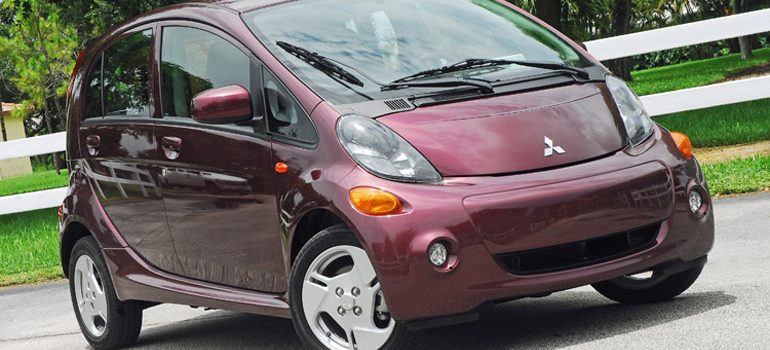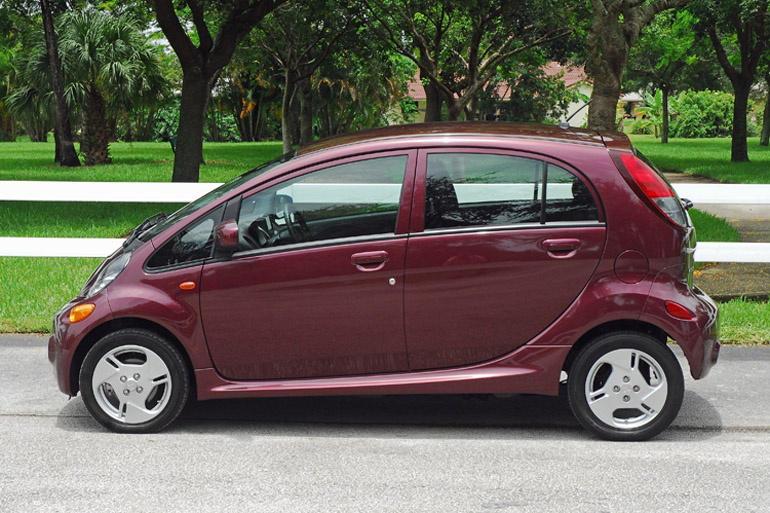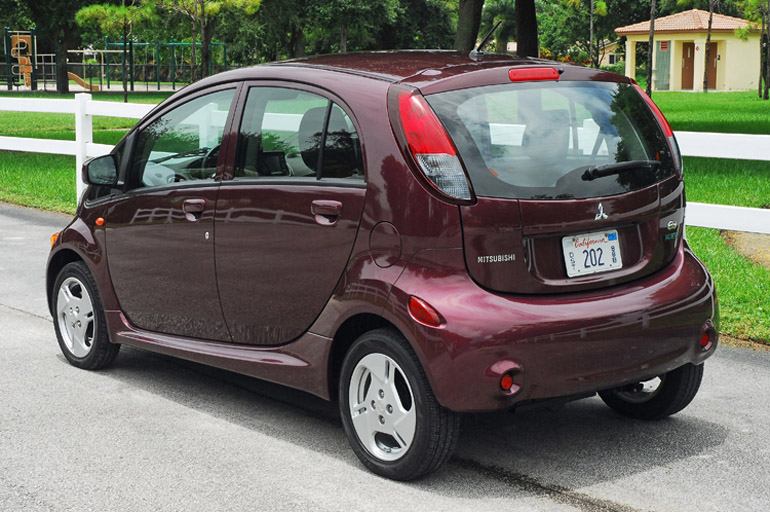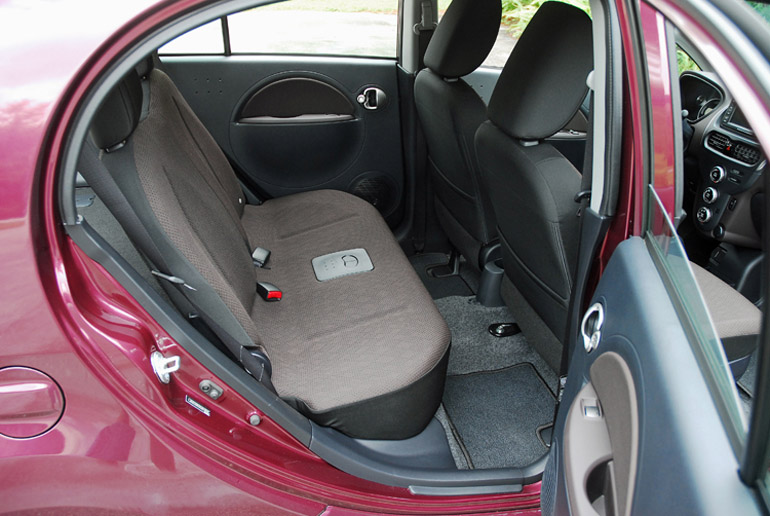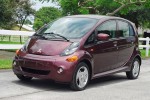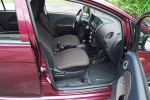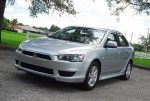
The Mitsubishi i-MEV electric four-seat sedan is a fully electric-powered automobile that will give consumers looking to save money on gas and save the environment from harmful emissions is here now in the U.S. First introduced in 2013, but already marketed around the world, the Mitsubishi i-MEV is ready to transform thoughtful consumers here in America.
Highly efficient, lightweight yet powerful, and proven to be reliable to the extreme, the electric powertrain that provides the motive force for the new i-MEV is a paragon of engineering excellence and is an evolution of the Japanese auto manufacturer’s highly developed electric motors and accompanying transmissions that have powered the company’s groundbreaking 100% battery-powered electric vehicles through its rich history.
Weighing all of 108 lbs. the electric motor powering the Mitsubishi I features numerous high-tech elements that aid in the area of efficiency, performance and reliability. Adoption of a synchronous permanent magnetic motor design helps reduce weight and makes for an electric motor of more compact dimensions. Electric motor reliability is also improved through the use of an advanced neodymium magnet-far and away the strongest type of permanent magnet for use in an electric motor. Also adding to the electric motor’s durability and efficiency are a highly-effective water-cooling system along with a high-performance casing that is not only dust resistant but also completely waterproof. Noise, vibration and harshness produced by the electric motor have been all but eliminated thanks to computer-aided design and analysis. As a result, the electric motor in the i-MEV is completely maintenance-free and backed by a 5-year/60,000 mile powertrain warranty. The electric motor produces 49 kW at 3,000 to 6,000rpm and 145ft.lb. of torque from 1-300rpm. Because all of the 145ft.lb. of torque are available at any rpm, standing start acceleration is ideal for stop-and-go urban driving. Maximum rotation speed of the electric motor is 9,000rpm. Because of the single fixed speed transmission-occupants inside will never experience the sort of momentary hesitation that occurs in a manual or automatic transmission with multiple gears. Compact in size and weight yet offering excellent performance and refined operation, the fixed gear ratio transmission of i-MEV is engineered to make the most of the electric motor’s high toque output and a wider power band. The 7.065 gear ratio has been selected for use as research and testing has determined this to be the best ratio for optimum dynamic performance from the electric motor. This fixed gear ratio, along with a simplified two-stage parallel shaft reduction and a conventional differential unit, distribute motor torque to the vehicle’s rear wheels. Strong yet sturdy, this remarkable transmission measures less than 7-inches in length and weighs less than 42lbs. when mated to the electric motor, the combined transmission/motor measures less than 19 inches long and weighs only 143 lbs.-a fraction of the weight of the typical internal combustion engine and transmission pairing. It is smooth and quiet as you quickly increase speed on the road.
The Motor Control Unit (MCU) is a critical component of a 100% electric-powered vehicle as it manages and regulates the electrical power supply to the electric motor to generate the necessary level of torque to power the vehicle by converting the battery packs DC voltage into three-phase AC. Conversely, the MCU is responsible managing the electrical energy that is produced by the regenerative braking system and is fed back into the lithium-ion battery pack. The battery pack is located beneath the vehicle sub-floor to maximize interior space, improve the center of gravity for stable handling performance and to keep passengers away from high voltage.
Compact in size yet amazingly space efficient and structurally sound, the North American spec Mitsubishi I 100% electric powered vehicle is based on a platform that has served tens of thousands of consumers well in markets around the world. The North American spec I is both wider and longer than the others. While much of its additional length (145 inches overall-an increase of nearly 8 inches) can be attributed to the accommodation of larger bumpers front and rear, the vehicle’s interior cabin width has grown by about 4.5 inches than the others, making a noticeably increased amount of elbow room for both the vehicle’s front and rear occupants.
Giving those occupants and driver a robust, comfortable and compliant ride is the MacPherson strut front and 3-link De-Dion type rear setup. The vehicle’s pull straight-line stability has been improved by increasing both the caster angle and caster trail while decreasing the amount of kingpin offset when compared to the European version. Already proven and well-sorted design, the 3-link De-Dion rear is shared by both the North American and European Mitsubishi electric vehicles and has been modified slightly for the U.S.-spec car to accept wider tires. Every North American specs i-MEV is equipped with a specially-designed set of low rolling resistance tires that feature a unique tread pattern. Manufactured by Dunlop Tires, the vehicle has been fitted with Enesave O1W/S-145/65R15 inch front and 175/60R15 inch tires in the rear.
When steering the new Mitsubishi i-MEV you might think that you are driving a gasoline powered vehicle. Mitsubishi engineers spent a great deal of time and effort in developing a pinion-driven Electric Power Steering (EPS) system that is complemented by technologically-advanced EPS+ software that communicates well with you, enabling a natural and nimble degree of steering feel whether making a tight cornering maneuver at low speed or negotiating a sweeping bend at a fast speed. With its low center of gravity as well as the design with the wheels pushed to the corners, the i-MEV offers an excellent degree of composure and surprisingly athletic handling I didn’t expect. Also, like a gasoline-powered electric hybrid, the motor of the car shuts down when the vehicle comes to a complete stop at an intersection, stop-and-go traffic or traffic signal.
When developing the braking system for i-MEV’s breakthrough electric vehicle, engineers paid particular attention to making sure that the system would offer you a very good braking feel rather than an odd and artificial sensation when applying the brakes. All of the car’s brakes feature ABS, EBD, BA, Traction Control and Active Stability Control to give me the same safety features found on today’s modern sedans. Unique to the braking system’s design is that this brake assist mechanism is integrated directly into the brake booster. This greatly enhances vehicle safety in panic braking because when the system detects that when I am depressing the brake pedal in a quick and abrupt manner, the brake booster and the brake assist mechanism reach full power instantaneously without the additional force required from my foot as is the case with a conventional hydraulic braking system. Another distinctive design element to the braking system is an electric brake vacuum pump as the power source of the vacuum brake booster that takes the place of the design common in internal combustion engine powered vehicles-one that relies on intake manifold vacuum pressure to power a brake booster. The electric brake vacuum pump does not operate full-time but activates on-demand when necessary. The brake feel is always linear, smooth and powerful as you put more pressure on the brake pedal.
There are two models available for i-MEV, the entry-level ES and the premium SE version (which I tested). Standard in both is the driver’s gauge cluster, handy new pocket storage bins, utilization of new environmentally-friendly materials and the adoption of Mitsubishi’s convenient MIEV remote system as standard while offering upscale options including 7-inch LCD HDD navigation with FUSE Handsfree Link System that allows the operation of an iPod docked via USB input or a Bluetooth enabled cell phone simply by voice commands. The center console on the SE trim level is a center stack that is now colored in deep, rich ebony hue. The trio of HVAC control dials-now done up in bright silver-contrast against their black background. Other stylish accents include bright silver-color rings for the main gauge face on the instrument cluster. I also enjoyed the full leather wrapped steering wheel and shift knob, new door trim with cloth inserts and upgrade seating surface material. Other standard equipment in the SE package include power windows/door locks, power-remote sideview mirrors, self-dimming rearview mirror, A/C, premium audio system with 8-speakers, grab handles, overhead map light, variable-speed wipers/washer, and floor mats front/rear.
Standard safety systems include four-3-point safety belts with front pretensioners/load limiters, a rigid occupant safety cell platform with front/rear/side energy-absorbing sections, front dual-stage airbags, front seat-mounted impact airbags, roof-mounted curtain side-impact airbags, LATCH system for child seats, Tire Pressure Monitoring System and an Acoustic Vehicle Alerting System to warn pedestrians of your advancing vehicle.
The new 2013 Mitsubishi i-MEV gets about 62 miles on the road but that also depends on how you drive and what accessories are in use. The manufacturer’s retail price starts at $29,125.00. If you are looking for a full electric vehicle because you drive up to just 60 miles per day than look at the new i-MEV.
Finally, there are three ways to recharge the car. The level 1 is an onboard charging system that allows you to charge the car in a variety of locations. The portable charging cable plugs into a standard 120V/15-amp dedicated household outlet, protected by a ground-fault circuit interrupter. It takes about 22-hours to charge. The level 2 is a fast, convenient home charging system. Developed by Eaton, the 240V outlet gives you a charge in just 7-hours and can be installed in your garage. The level 3 charging system is an optional quick-charger port so you can plug in, grab a cup of coffee, and be 80% charged in just ½ hour. See your Mitsubishi dealer for more details about the car to answer any questions.
COPYRIGHT: 2013: HARVEY SCHWARTZ
